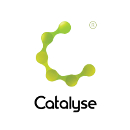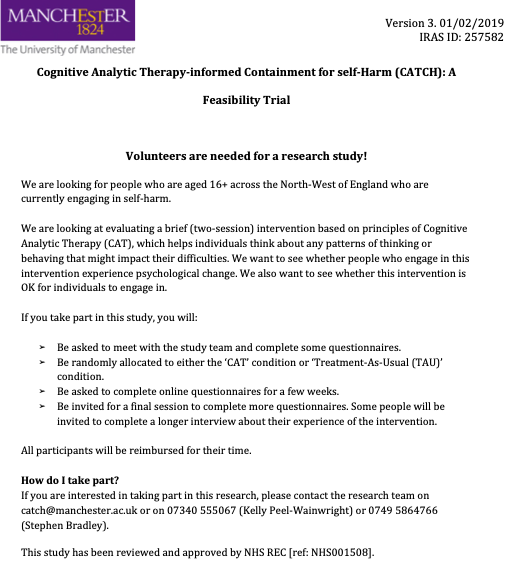In her first Catalyse blog, Kathryn Pemberton reflects on moments in her role as production manager during the creation of the series of twelve training films on cognitive analytic therapy (CAT).
It is early, on a wintery Sunday morning and for the past ten minutes I’ve been shuffling around a car park in deepest darkest North Manchester. I’m suddenly very conscious that to anyone watching, my behaviour must look rather strange, if not a little bit suspicious. I am not alone either. Three dark clothed men, and my colleague, Dawn Bennett, are also here. Our heads are down, eyes focussed on the floor, all determinedly shuffling away. An observer might mistakenly think we are simply trying to stay warm, or else are possibly trying to locate a lost item in the snow. Perhaps we have been caught in a moment of intense social awkwardness…
Actually, it’s none of these things. We are here to shoot the new Catalyse training films and the three dark clothed men are members of our production crew. This morning we need to get a series of exterior shots which reflect the passage of time. The films we are shooting span five months in the life of Paul and his therapist, Lisa over the course of a sixteen session CAT. The next scenes to be shot are set towards the end of the therapy. It’s supposed to be June, and snow simply does not suggest early summer. Hence the obsessive shuffling as we attempt to kick aside the smattering of snow so it is out of shot.
We have two days to get everything filmed – yesterday we completed most of the interior scenes; a busy day with a very tight schedule and somewhere around a dozen costume changes for the actors. There’s a playful but focussed atmosphere, everyone is pulling together and there’s a definite air of excitement in the (nippy) air. Alongside this there is also, for me, a sense of responsibility. These filming days mark the culmination of months of planning and preparation in my role as production manager. I’ve been accompanied on this venture by Catalyse trainers offering much needed consultancy: Dawn Bennett, Glenys Parry and Mark Evans.
It all started as an idea reflecting a need. A series of high quality, affordable and accessible training films on cognitive analytic therapy (CAT). We started with a blank slate and lots of questions. What did we want the films to show? What was their function? Should we use actors or ‘real’ people or a mixture of both? Improvised or scripted? Should we show examples of ‘good’ therapy and then ‘bad’ therapy?
At this point we had more questions than answers and so we concentrated on what we did know. We wanted the films to be multi-functional, a training tool for different courses and services. They needed to be useful for individuals training in, or already trained in CAT. We also knew we wanted to demonstrate skills and competences using both content and process. Finally, the way the information was communicated needed to be in line with the ethos of CAT. It needed to be collaborative, scaffolding and encouraging the viewer to be an active agent in their learning.
Gradually, we began to answer some of the other questions. Quite early on we decided to use an actor for the role of Paul, the client. We were lucky enough to find a junior doctor for the role of Lisa, the CAT therapist, who had used CAT in her practice, and also had acting experience. The planets were beginning to align…
We also knew that we wanted the therapy to be realistic, and therefore, imperfect, but ‘good enough’. In doing so, we wanted to encourage debate and to get people reflecting on their own practice. For example if they didn’t agree with some of the decisions or actions of the therapist, we wanted the viewer to be curious about why they disagreed and to consider what they might do differently.
Initially, I envisioned the scenes to be semi-improvised. A rough idea of the content and scripted ‘plot points’ would guide the actors through the main content required in the scene. However, we learned during initial rehearsals that without full control of the content and the words used, we couldn’t guarantee that specific learning points would be covered. We also couldn’t be sure of the length of each film.
At this point, two things dawned on me. Firstly, I was going to have to write twelve scripts. This was the easy part in some ways as I have always written bits and pieces of plays and screenplays. The harder part was breaking it to our lovely actors that they were going to have to learn it all!
Rehearsals were looming. I had finished the scripts and the Catalyse team had studied them. We’d all agreed on the accuracy and quality of the content. By the end of this process, the actors had just two weeks to learn them. To their absolute credit, they took this request in their stride and duly learned twelve scripts in two weeks, turning up to rehearsals practically word perfect.
And that is how I found myself with numb toes, trying to bring summer to a snowy carpark in Manchester. We were lucky. The weather held, the snow stayed out of shot and we got the scenes we needed of Paul in his car (film 11, revision through recognition) before hurrying inside to defrost.
Once the filming was complete, we entered the post production period. This was where the production company edited the rough cuts, adding the on-screen text and voice overs. I can only liken this process to waiting for an exam result. I trusted that the production company had understood all our notes and directions – and had taken on board my constant requests for close ups of the SDR. The production company were very patient (how many CAT therapists does it take to agree on an edit…). At times my requests must have felt rather pedantic, but we knew the value was in the detail, and it was important to get it right.
At last, after several weeks of post-production, we all agreed on the final edit. Twelve, high quality, multifaceted, accessible training films, reflecting the ethos of CAT, and some lovely close ups of the SDR to boot.
Now we just had the small matter of the 80 page supporting materials to write…
You can find out more about the CAT training films and watch a two minute trailer at this link.
If you’re interested in using the films and supporting materials in your training or learning, check out the subscription options listed there. A discounted rate applies for ACAT members and ACAT-accredited training courses.
.






